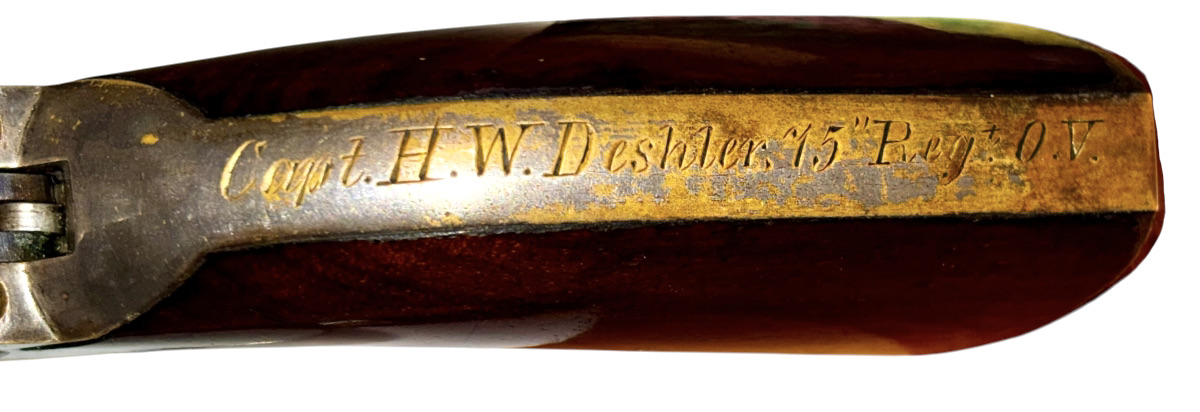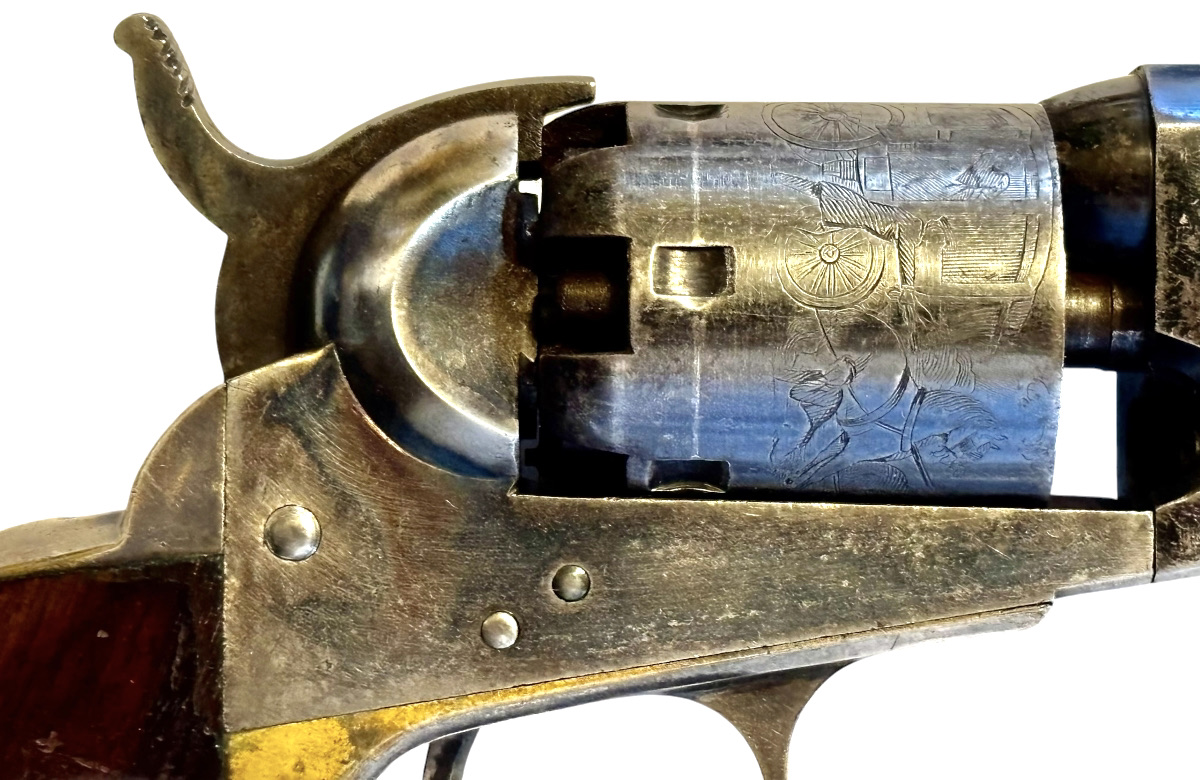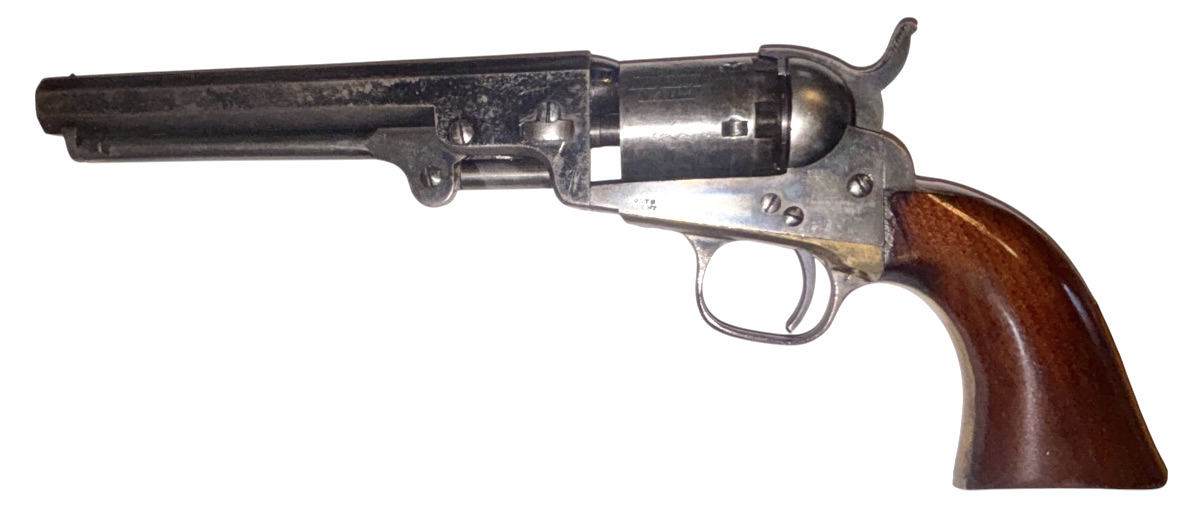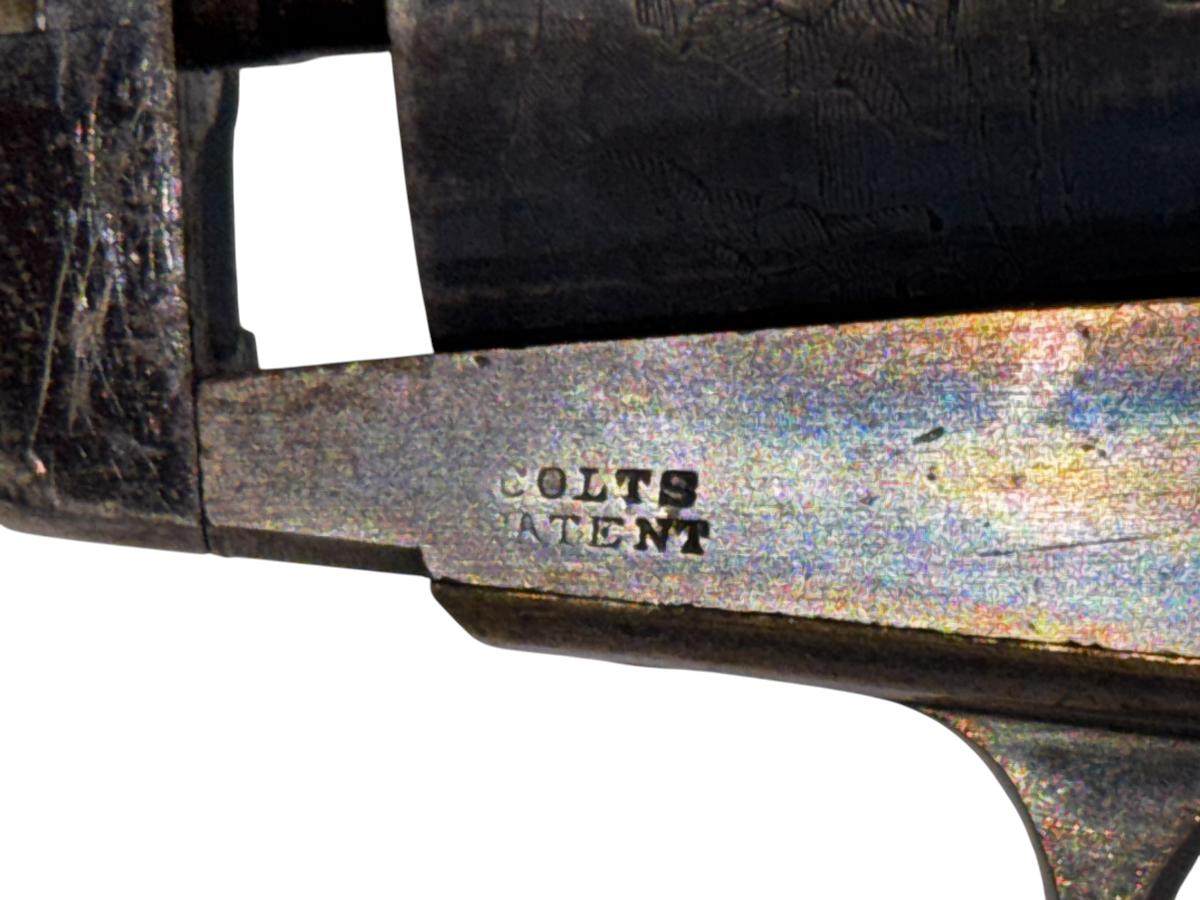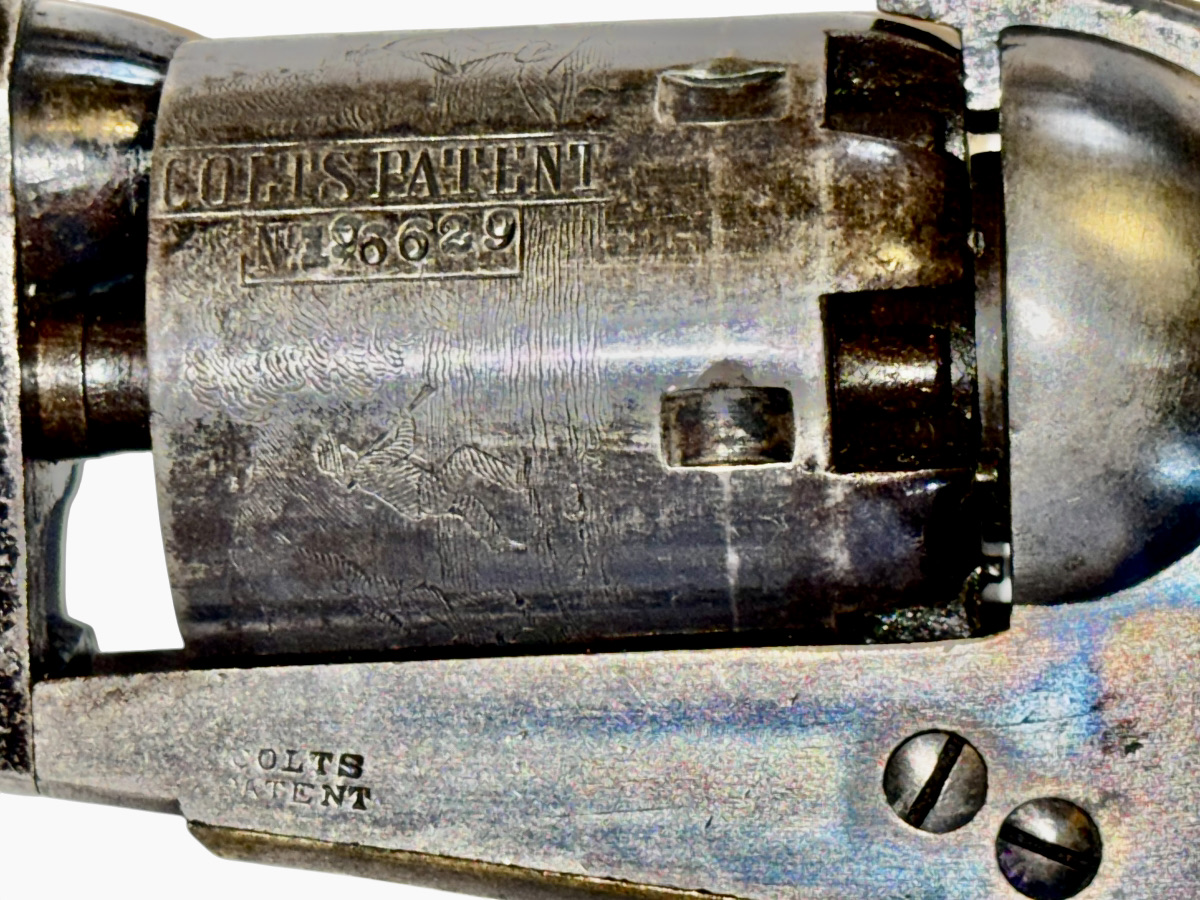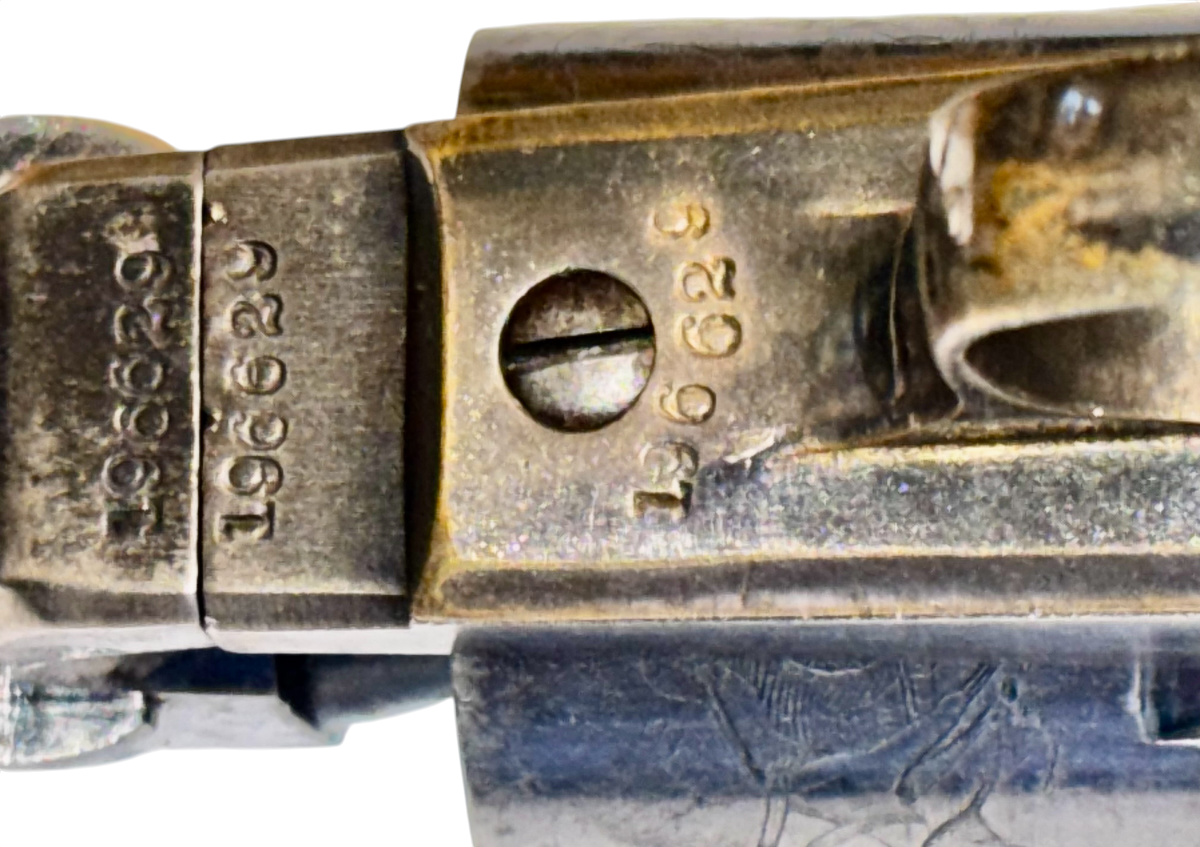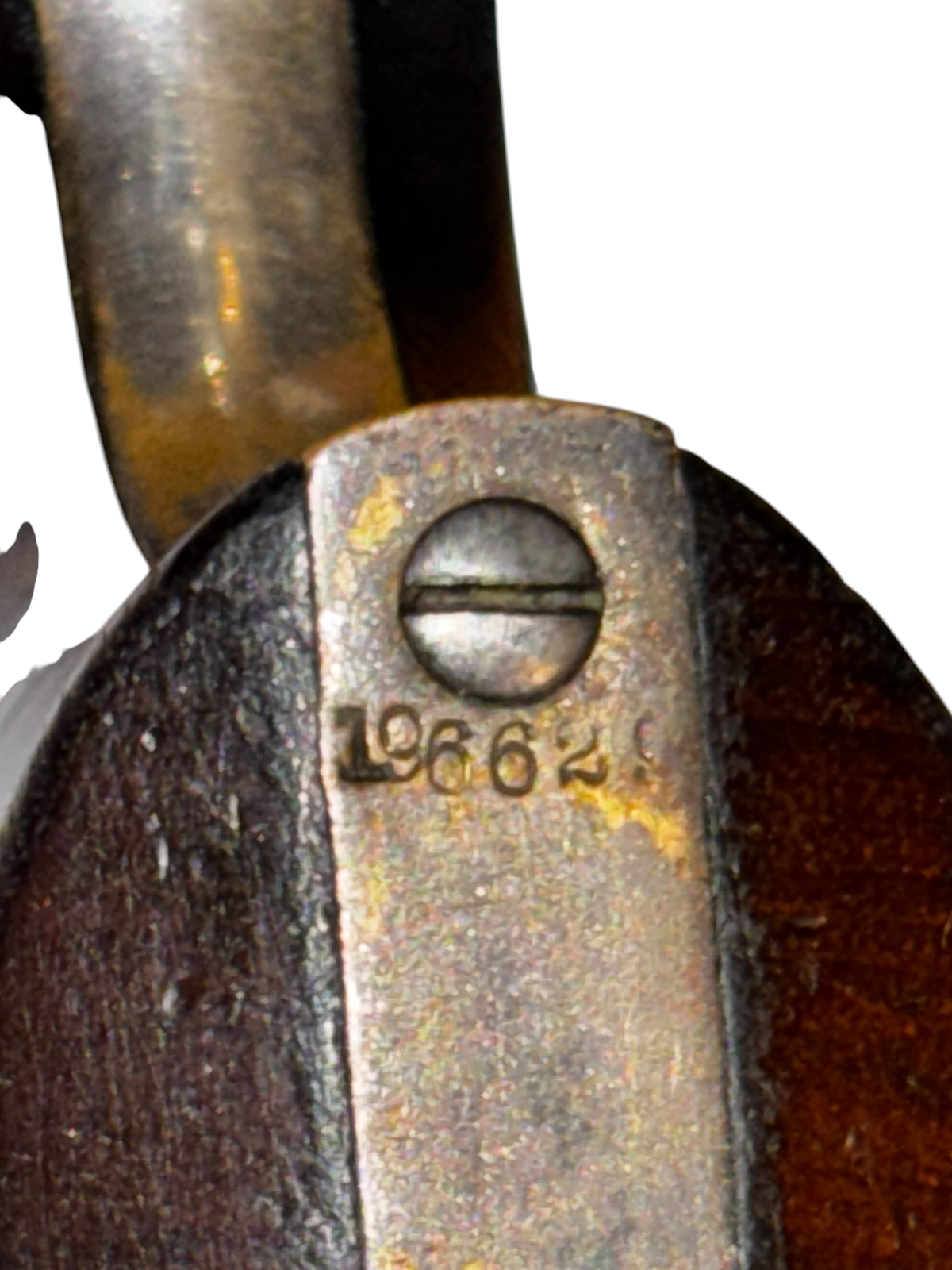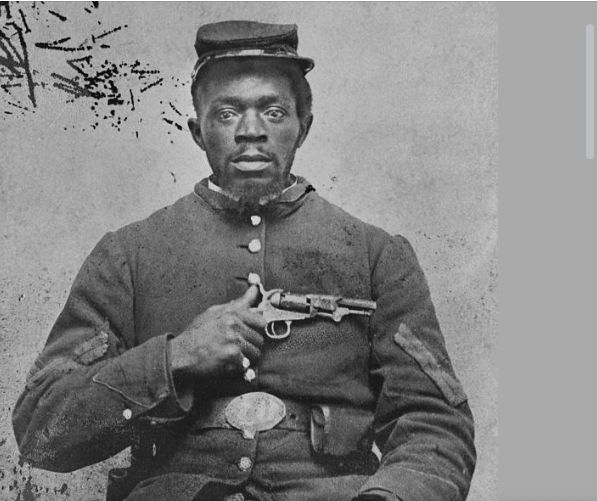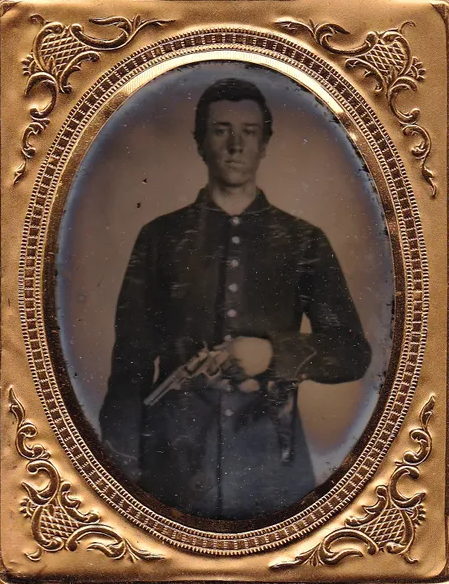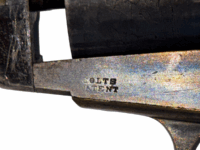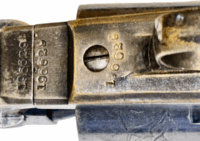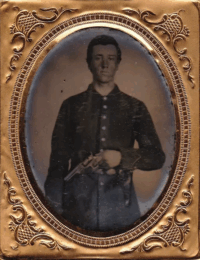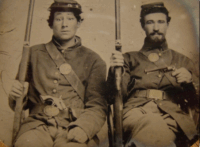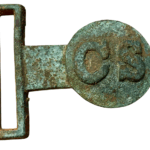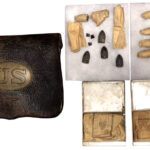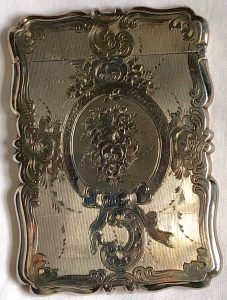Id’d Colt M1849 Pocket Model Revolver
SOLD
Id’d Colt M1849 Pocket Model Revolver – This Colt Pocket model is perhaps the finest one that we have had; it remains in fine untouched condition, bordering on minty. The revolver is inscribed on backstrap with the following:
“Capt. H. W. Deshler, 75thRegt O.V.”
The revolver features the typical .31 cal. and 5-shot configuration and has a 6” barrel. The serial number is 196629, indicative of manufacture in 1861; all of the pistol’s numbers match, including the wedge. The barrel and cylinder retain much of their original blue, and the frame, loading lever, and hammer all retain extensive original case color. The grips on this pocket revolver are nearly mint, retaining all of their original varnish. The pistol exhibits fine action and mechanical function and has a superb bore. Capt. Deshler left the service in January 1863; we surmise that he must have only briefly owned and subsequently rare used this pistol, as it remains in near mint condition.
The pistol is accompanied by a “Colt Letter”, indicating that the gun was shipped to: “J. P. Moores Sons, New York, New York” on October 25, 1861. Additional voluminous research will also be included, that details Capt. Deshler’s military and civilian life.
A summary of Captain Deshler’s life:
- Born in 1832; appears as a schoolteacher in the 1860 census
- At age 28, Deshler enlisted on April 21, 1862 in an Ohio infantry regiment, at the rank of 2nd
- On April 23, 1861, Deshler mustered into Co. B of the 22nd Ohio Infantry
- Deshler was commissioned into the 75th Ohio Infantry, Co. on 4/21/61
- He mustered out on 8/19/61 at Athens, Ohio
- Enlisted 10/20/61 as a private
- Commissioned into the 75th Ohio Infantry, Co. B on 10/20/61
- Promoted to Captain on 12/14/61
- Engaged in the following battles: McDowell, Cross Keys, 2nd Bull Run and others
- Resigned on 1/12/63 due to disability
- Married Mary E. Jackson on Oct. 22, 1863, in Ohio, later divorcing in 1872
- Remarried April 6, 1874, in Akron, Ohio
- Studied medicine to treat himself and others; he would sign documents with the title “Dr.”, from 1899 on
- Died on November 22, 1906 in the National Military Home, Columbus, Ohio; interred at the Soldier’s Home in Dayton, Ohio
Horace W. Deshler
Residence was not listed; 28 years old.
Enlisted on 4/21/1861 as a 2nd Lieut.
On 4/23/1861, he mustered into “B” Co. Ohio 22nd Infantry.
He was Mustered Out on 8/19/1861 at Athens, OH
OHIO TWENTY-SECOND INFANTRY (Three Months) Twenty-second Infantry – (Three Months’ Service.) Col., William E. Gilmore; Lieut.-Col., John A. Turley; Maj., Julius A. Penn. The several companies composing this organization were enrolled as follows; A, April 16, and C, April 21, at Chillicothe; B, April 21, and H, April 13 to May 2, at Athens; G, May 4 to 12, at Portsmouth; E, April 23, at Batavia; F, April 20, at Washington C. H.; I, April 24, at Felicity, and K, April 26, at Greenfield. The companies arrived at Camp Jack- son, Columbus, when it was soon learned that the quota under the first call had been filled and that nine additional regiments were in camp in excess of the quota. The state being on the border and liable to invasion at any moment by the enemy, it was decided that they should be held as state troops and accordingly this regiment was mustered into state service for a period of three months. The regimental organization being com- plete, it left Camp Jackson on May 30, en route to Parkersburg, W. Va., under orders. Near Raysville, Vinton County, there was a railroad accident, in which 4 men lost their lives, and 14 others were injured so badly that they were never able to re- join the regiment for duty. Arriving at Parkersburg, it fortified Jackson’s hill and the approaches to the bridge on the Kanawha River. It remained at Parkersburg some days, when reinforcements arrived and it moved to Burning Spring and Elizabethtown to protect the lives and property of Union citizens that were in danger. It dispersed the marauders and from there sent the first prisoners of the war to Camp Chase. It next marched to Three Forks and scattered a body of the enemy just forming a camp. It then made a forced march to Glenville to reinforce three companies of the 7th Ohio, who were in danger of being captured. At Glenville several detachments went on expeditions into the mountains of Gilmer, Calhoun and Braxton counties to break up Confederate organizations. This service and guarding the important bridges, trestles and tunnels of the railroads were zealously and faithfully performed throughout its term. The 22nd was connected with no other part of the army. It was in no considerable engagements, but had several small skirmishes with bands of the enemy, and aside from the railroad accident above mentioned, its casualties were slight -only 2 men wounded. Its term of service being about to expire, it was ordered home to be mustered out of service, which occurred on Aug. 19, 1861.
Horace W. Deshler
Residence was not listed; 28 years old.
Enlisted on 10/20/1861 as a Priv.
On 10/20/1861, he was commissioned into “B” Co. Ohio 75th Infantry.
He resigned on 1/12/1863
Promotions:
- Capt 12/14/1861
75th Ohio Infantry
OHIO SEVENTY-FIFTH INFANTRY (Three Years) Seventy-fifth Infantry. – Cols., Nathaniel C. McLean, Robert Riley, Andrew L. Harris; Lieut.-Cols., Robert A. Constable, Charles W. Friend, Benjamin Morgan; Maj., George B. Fox. This regiment was organized at Camp John McLean from Nov. 7, 1861, to Jan. 8, 1862, to serve for three years. The original members (except veterans) were mustered out by detachments at
different dates from Nov. 16, 1864 to Jan. 17, 1865, by reason of expiration of term of service, and the veterans and recruits consolidated into a battalion of two companies, which was retained in service until July 27, 1865, when it was mustered out in accordance with orders from the war department. The following is the official list of battles in which this regiment bore an honorable part, as given in the Official Army Register: Monterey, Shaw’s ridge, McDowell, Franklin, Strasburg, Cross- Keys, Cedar mountain, Freeman’s ford, Waterloo bridge, Sulphur springs, second battle of Bull Run, Aldie, Chancellorsville, Gettysburg, Hagerstown, Fort Wagner, John’s island, Camp Bald- win, Gainesville, Pocataligo bridge, Charleston. At Monterey the regiment displayed bravery and gave evidence of the fine discipline to which it had attained under the teachings of the officers of the regiment. At McDowell it added new laurels to its former good name under the immediate eye of Gen. Milroy, who warmly congratulated Col. McLean on the gallantry of his regiment. It lost 88 men killed and wounded. It also lost heavily at Freeman’s ford, which was also true at the second Bull Run – 22 killed and 93 wounded. In the short space of half an hour at Chancellorsville the regiment lost 150 men killed and wounded. It was under fire every day of the battle at Gettysburg, where out of 292 enlisted men, 63 were killed, 106 wounded and 34 captured. In the unfortunate affair at Gainesville, Fla., 14 men were killed and 32 wounded, who together with about 72 others were taken prisoners.
75th Regiment, Ohio Infantry
Overview:
Organized at Camp McLain, Cincinnati, Ohio, November 7, 1861, to January 8, 1862. Left State for Grafton, W. Va., January 28, 1862. Attached to Milroy’s Command, Cheat Mountain, District West Virginia, to March, 1862. Milroy’s Brigade, Dept. of the Mountains, to April, 1862. Schenck’s Brigade, Dept. of the Mountains, to June, 1862. 2nd Brigade, 1st Division, 1st Corps, Army of Virginia, to September, 1862. 2nd Brigade, 1st Division, 11th Army Corps, Army of the Potomac, to July, 1863. 2nd Brigade, Gordon’s Division, Folly Island, S. C., 10th Army Corps, Dept. of the South, to February, 1864. 1st Brigade, Ames’ Division, District of Florida, to April, 1864. District of Florida, Dept. of the South, to October, 1864. 4th Separate Brigade, Dept. of the South, to December. 1864. 1st Brigade, Coast Division, Dept. of the South, to January, 1865. 4th Separate Brigade, Dept. of the South, to July, 1865.
Service:
March to Huttonville February 17-March 1, 1862. Expedition to Lost River Region April 1-12. Action at Monterey April 12. Battle of McDowell May 8. Retreat to Franklin May 10-12. Franklin May 29. Pursuit of Jackson to Shenandoah Valley. Strasburg and Staunton Road June 1-2. Mt. Jackson June 3. New Market June 4. Harrisonburg June 6. Battle of Cross Keys June 8. At Middletown till July 7, and at Sperryville till August 8. Reconnoissance to Madison Court House July 16-19. Battle of Cedar Mountain August 9. Pope’s Campaign in Northern Virginia August 16-September 2. Freeman’s Ford August 22. Battle of Bull Run August 29-30. Duty in the Defences of Washington, D. C., till December. Expedition from Centreville to Bristoe Station and Warrenton Junction September 25-28. March to Fredericksburg, Va., December 10-15. “Mud March” January 20-24, 1863. At Falmouth till April 27. Woodstock and Cedar Run February 26. Chancellorsville Campaign April 27-May 6. Battle of Chancellorsville May 1-5. Gettysburg (Pa.) Campaign June 11-July 24. Battle of Gettysburg July 1-3. Pursuit of Lee July 5-24. Moved to Morris Island, S. C., August 6-12. Siege operations against Fort Wagner, Morris Island, S. C., and against Fort Sumpter and Charleston August 18-September 7. Capture of Fort Wagner and Gregg, Morris Island, September 7. Moved to Folly Island, S. C., and duty there till February 22, 1864. Expedition to John’s and James’ Islands February 6-14. Ordered to Jacksonville, Fla., February 22, 1864. Regiment mounted and duty in the District of Florida till December 8. Expedition from Jacksonville to Cedar Creek April 2. Cedar Run April 2. Expedition to Headwaters of the St. Johns and Kissinee Rivers April 25-May 10, destroying and capturing a large amount of stores and property. Action near Jacksonville April 28. Near Camp Finnegan May 25. Expedition from Jacksonville to Camp Milton May 31-June 3. King’s Creek, S. C., July 3 (Detachment). Raid from Jacksonville to Baldwin July 23-28. Near Trail Ridge July 25. Action at St. Mary’s Trestle July 26. Camp Baldwin August 12. Raid on Florida Railroad August 15-19. Gainesville August 17. Expedition to Enterprise September 28. Companies “A,” “B,” “C,” “D,” “F” and “G” mustered out October and November, 1864. Balance moved to Hilton Head, S. C., December 8-10. Pocotaligo Bridge, S. C., December 29. Returned to Florida January, 1865, and duty at District Headquarters, Jacksonville, and at Tallahatchie, Fla., till July. Mustered out July 15, 1865.
Regiment lost during service 4 Officers and 110 Enlisted men killed and mortally wounded and 2 Officers and 101 Enlisted men by disease. Total 217.
75th Ohio Infantry Regiment
United States Regiments & Batteries > Ohio > 75th Ohio Infantry Regiment
The 75th Ohio Infantry Regiment lost 4 officers and 110 enlisted men killed or mortally wounded and 2 officers and 101 enlisted men to disease during the Civil War. It is honored by two monuments at Gettysburg shared with the 25th Ohio Infantry.
| 1861 | |
| November 7 | Organization of the 75th Ohio Infantry Regiment begun at Camp McLain, Cincinnati, Ohio under the command of Colonel Nathaniel C. McLean, Lt. Colonel R.A. Constable and Major Robert Reily. |
| 1862 | |
| January 8 | Organization completed |
| January 28 | The 75th Ohio Infantry Regiment left the state for Grafton, Va. Attached to Milroy’s Command, Cheat Mountain, District West Virginia |
| February 17-March 1 | March to Huttonville and attached to Milroy’s Brigade, Dept. of the Mountains |
| April 1-12 | Expedition to Lost River Region attached to Schenck’s Brigade, Dept. of the Mountains |
| April 12 | Action at Monterey |
| May 8 |
Battle of McDowellThe Regiment lost 87 men |
| May 10-12 | Retreat to Franklin |
| May 29 | Franklin |
| June 1-2 | Pursuit of Jackson to Shenandoah Valley, Strasburg and Staunton Road |
| June 3 | Mt. Jackson |
| June 4 | New Market |
| June 6 | Harrisonburg |
| June 8 |
Battle of Cross Keys |
| June 26 | At Middletown, attached to 2nd Brigade, 1st Division, 1st Corps, Army of Virginia. Colonel McLean was given command of the brigade |
| July 7 | At Sperryville |
| July 16-19 | Reconnaissance to Madison Court House |
| August 9 |
Battle of Cedar Mountain |
| August 16-September 2 |
Pope’s Campaign in Northern Virginia |
| August 22 | Freeman’s Ford |
| August 29-30 |
Second Battle of Bull Run (Manassas)The Regiment lost 113 men. The colors were riddled with over 90 holes. |
| September-December | Duty in the Defenses of Washington, D.C. attached to 2nd Brigade, 1st Division, 11th Army Corps, Army of the Potomac |
| September 25-28 | Expedition from Centreville to Bristoe Station and Warrenton Junction |
| November 29 | Colonel Nathaniel C. McLean promoted to brigadier general |
| December 3 | Lt. Colonel R.A. Constable promoted to colonel and Major Reily to lieutenant colonel |
| December 10-15 | March to Fredericksburg, Va. |
| 1863 | |
| January 12 | Colonel Constable resigned |
| January 20-24 |
“Mud March” |
| February-April | At Falmouth |
| February 26 | Woodstock and Cedar Run |
| March 3 | Lieutenant Colonel Reily promoted to colonel |
| April 27-May 6 |
Chancellorsville Campaign |
| May 1-5 |
Battle of ChancellorsvilleThe Regiment in a half hour lost 150 casualties, including Colonel Reily, who was was mortally wounded. |
| May 22 | Andrew L. Harris promoted to colonel |
| June 11-July 24 |
Gettysburg Campaign |
| July 1-3 |
Battle of GettysburgThe 75th Ohio was commanded at Gettysburg by Colonel Andrew L. Harris, who took command of the brigade on July 1. Captain George B. Fox then took over the regiment. The Regiment lost 16 killed 16, 96 wounded 96, and 71 missing, a total of 183. From the monument: Arriving at Gettysburg from Emmitsburg July 1, 1863, The 25th and 75th Ohio Infantry advanced beyond the town and, under a heavy cannonade, took position here, supporting Battery G, 4th U.S. Artillery. During July 2 and 3, they held an advanced line on East Cemetery Hill, and early July 4 led the advance into the town. < See Colonel Harris’s Official Report on the 75th Ohio at Gettysburg > |
| July 5-24 | Pursuit of Lee |
| August 6-12 | Moved to Morris Island, S.C. and attached to 2nd Brigade, Gordon’s Division, Folly Island, S.C., 10th Army Corps, Dept. of the South |
| August 18-September 7 | Siege operations against Fort Wagner, Morris Island, S.C., and against Fort Sumpter and Charleston |
| September 7 | Capture of Fort Wagner and Gregg, Morris Island |
| September | Moved to Folly Island, S.C. |
| 1864 | |
| February 6-14 |
Expedition to John’s and James’ islands |
| February 22 | Ordered to Jacksonville, Fla. Regiment mounted and attached to 1st Brigade, Ames’ Division, District of Florida |
| April 2 | Expedition from Jacksonville to Cedar Creek; Cedar Run |
| April 25-May 10 | Expedition to Headwaters of the St. Johns and Kissinee Rivers, destroying and capturing a large amount of stores and property. Attached to District of Florida, Dept. of the South |
| April 28 | Action near Jacksonville |
| May 25 | Near Camp Finnegan |
| May 31-June 3 | Expedition from Jacksonville to Camp Milton |
| July 3 | King’s Creek, S.C. (Detachment) |
| July 23-28 | Raid from Jacksonville to Baldwin |
| July 25 | Near Trail Ridge |
| July 26 | Action at St. Mary’s Trestle |
| August 12 | Camp Baldwin |
| August 15-19 | Raid on Florida Railroad |
| August 17 | Gainesville |
| September 28 | Expedition to Enterprise |
| October – November, | Companies A, B, C, D, F and G mustered out. Remaining companies attached to 4th Separate Brigade, Dept. of the South |
| December 8-10 | Companies E, H, I and K moved to Hilton Head, S.C. and attached to 1st Brigade, Coast Division, Dept. of the South |
| December 29 | Pocotaligo Bridge, S.C. |
| 1865 | |
| January | Returned to Florida and duty at District Headquarters, Jacksonville, and at Tallahatchie, Fla. attached to 4th Separate Brigade, Dept. of the South |
| July 15 | The 75th Ohio Infantry Regiment mustered out |
75th Ohio Infantry Regiment
| 75th Ohio Infantry Regiment | |
| Active | 1861–1865 |
| Country | United States of America |
| Allegiance | Union |
| Branch | Union Army |
| Type | Infantry |
| Size | 984 at outset of service |
| Engagements | |
| Ohio U.S. Volunteer Infantry Regiments 1861-1865 | ||||
|
The 75th Ohio Infantry Regiment, sometimes 75th Ohio Volunteer Infantry was an infantry regiment from southwestern Ohio in the Union Army during the American Civil War. It served in the Eastern Theater, most notably in the battles of Chancellorsville and Gettysburg and then in the siege operations against Charleston, South Carolina.
Service history
1862
The infantry regiment was organized at Camp John McLean near Cincinnati, Ohio, from November 7, 1861, to January 8, 1862, to serve three years. The 75th Ohio was initially led by Col. Nathaniel C. McLean, Lt. Col. Robert A. Constable and Maj. Robert Reily. The regiment began its service with 984 officers and men. Among the enlistees was future U.S. Congressman Henry Lee Morey.
The 75th was initially sent to augment the Union forces in the Shenandoah Valley region of Virginia. It soon participated in defending what became known as Stonewall Jackson‘s Valley Campaign. On May 8, 1862, at the Battle of McDowell, the regiment lost 87 men. It fought again at Cross Keys before being sent eastward to reinforce the Union troops after the Peninsula Campaign.
The 75th OVI then participated in the subsequent Northern Virginia Campaign and fought in the Second Battle of Bull Run, where it lost 113 men. Within a month, it saw action at the Battle of South Mountain in Central Maryland.
1863 – Chancellorsville
During the Battle of Chancellorsville in May, the 75th Ohio was part of the 2nd Brigade, 1st Division of the XI Corps in the Army of the Potomac. During the battle, the XI Corps was far from the Confederate army, so their commander, Maj. Gen. Oliver O. Howard did not have them dig defenses in case of an attack despite being ordered to do so by Maj. Gen. Joseph Hooker.
On May 2, Confederate General Robert E. Lee decided on a daring and very risky plan. Knowing the XI Corps was not prepared for an attack, he sent General Thomas “Stonewall” Jackson and his Second Corps of 28,000 men on a 12-mile march around the Union right flank with the hope of catching the XI Corps by surprise.
At 4:30 in the afternoon, the 75th’s commander, Col. Robert Reily, had heard reports of a Confederate movement in his direction. Unlike many other commanders, including General Howard, Reily did not dismiss them. He prepared the 75th Ohio for an attack he knew was coming. He had his men lie down and rest by their guns and wait for the attack. Within a half-hour, Jackson’s Corps rushed out of the thick underbrush. When Jackson’s corps struck at about 5 p.m., the XI Corps was completely unprepared, many of the men engaged in eating supper. Most of the XI Corps was taken by surprise and broke for the rear without firing a shot. As other men of the XI Corps ran by in a panic, the 75th Ohio stood and fired back at the Confederates. They kept up the fire for ten minutes until the Confederates had overwhelmed their lines forcing them to retreat. In those ten minutes, Colonel Reilly was killed, while 150 other men of the 75th Ohio were killed or wounded.
1863 – Gettysburg
At the Battle of Gettysburg on July 1–3, 1863, the 75th Ohio, now under the command of Colonel Andrew L. Harris (future 44th Governor of Ohio), arrived with the rest of the XI Corps on the battlefield mid-day on July 1, 1863, the first day of the battle. The fighting had been going on since morning. As part of Brig. Gen. Francis C. Barlow‘s division, the 75th Ohio took a defensive position on Blocher’s Knoll (now known as Barlow’s Knoll), north of the town. Unfortunately, this slight rise in the terrain was too far forward in comparison to the other XI Corps divisions, and Barlow’s position formed a salient that could be attacked from multiple sides. Confederate Lt. Gen. Richard S. Ewell sent two brigades, those of Brig. Gen. George P. Doles and Brig. Gen. John B. Gordon, in a frontal assault on the knoll. Barlow’s division was overwhelmed, suffering serious losses, and Barlow was wounded and left on the field for dead. Harris led his men in a successful withdrawal through the hotly contested streets to Cemetery Hill, where they entrenched on the northeastern slope. Harris took command of the 2nd Brigade after its commander, Brig. Gen. Adelbert Ames, took Barlow’s place as commander of the 1st Division. George Benson Fox later took command of the 75th as Colonel Harris and other superior officers were wounded or killed in battle; and specifically in consequence of Commander J.C. Mulharen having been killed.
At around 7:30 at night on July 2, the 75th Ohio, positioned between the 25th Ohio Infantry and the 17th Connecticut Infantry regiments, now on a brickyard lane at the base of East Cemetery Hill, held off attacks by regiments of Brig. Gen. Harry T. Hays‘ “Louisiana Tigers” brigade. Overall, the Buckeyes lost 186 officers and men (16 killed, 74 wounded and 96 missing) at Gettysburg.
Actions later in the war
In August, the 75th OVI was transferred to Charleston Harbor, remaining in the trenches in South Carolina until September. The 75th then moved to Folly Island, and then to Florida, where the men were mounted and designated as mounted infantry. The regiment served in Florida until the close of the war, participating in the Battle of Gainesville on August 17. Six companies were mustered out in October and November 1864, while the veterans remained in the service until August 1865.
Commanders
- Colonel Nathaniel C. McLean– promoted to Brigadier General, December 3, 1862
- Colonel Robert Reily– killed May 2, 1863, at Battle of Chancellorsville
- Colonel Andrew L. Harris– mustered out with regiment on January 17, 1865; Brevet Brigadier General, March 13, 1865
- Colonel Charles W. Friend
- Major George Benson Fox– took command of the 75th Ohio at Battle of Gettysburg after all superior officers were wounded or killed.
- Captain James C. Mulharen – killed at Battle of Gettysburg July 2, 1863
Monuments
There are two combined monuments to the 25th and the 75th Ohio Regiments in the Gettysburg National Military Park. One is north of Gettysburg on East Howard Avenue on Barlow’s Knoll (their position on the First Day). The second is on Wainwright Avenue (approximating the former brickyard lane) on East Cemetery Hill (their position on the Second Day).
A monument to the 75th Ohio Volunteer Regiment exists at Camp John McLean Memorial Park in Wyoming, OH, dedicated in 2001. The site memorializes the training camp grounds for the regiment between October 1861 and January 1862, organized by Nathaniel McLean and Robert Reily.


